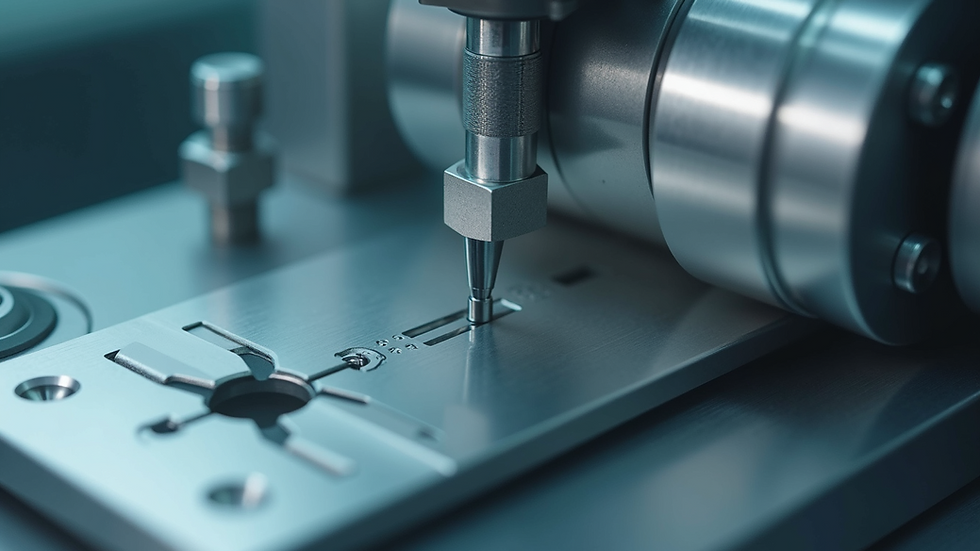Precision Components that Revolutionize Medical Innovation
- Dale Glenn- President/Owner
- Sep 2
- 4 min read
Updated: Sep 23
In the fast-evolving world of medical technology, the role of precision-engineered components cannot be overstated. These components form the backbone of many life-saving devices and instruments, enabling breakthroughs in diagnostics, treatment, and patient care. The demand for accuracy, reliability, and durability in medical devices has driven innovation in manufacturing processes, materials, and design. This article explores how precision components are transforming medical innovation, the technologies behind them, and their impact on healthcare outcomes.
The Importance of Precision-Engineered Components in Medical Devices
Precision-engineered components are critical in ensuring that medical devices perform with the highest level of accuracy and safety. These components are manufactured to exact specifications, often at microscopic tolerances, to meet stringent regulatory standards. Their applications range from surgical instruments and implantable devices to diagnostic equipment and drug delivery systems.
Key Benefits of Precision Components in Medicine
Enhanced Accuracy: Devices such as imaging machines and robotic surgical tools rely on components that deliver precise movements and measurements.
Improved Patient Safety: High-quality components reduce the risk of device failure, minimizing complications during medical procedures.
Miniaturization: Precision engineering allows for smaller, less invasive devices that improve patient comfort and recovery times.
Durability and Reliability: Components made from advanced materials withstand harsh sterilization processes and long-term use.
For example, in cardiac pacemakers, tiny precision springs and connectors ensure consistent electrical impulses that regulate heartbeats. Similarly, in orthopedic implants, precision-machined surfaces promote better integration with bone tissue.

How Precision-Engineered Components Drive Medical Innovation
The integration of precision-engineered components into medical technology has opened new frontiers in healthcare. Innovations in manufacturing techniques such as CNC machining, laser cutting, and additive manufacturing have enabled the production of complex parts with unparalleled accuracy.
Advanced Manufacturing Techniques
CNC Machining: Computer Numerical Control (CNC) machines produce components with tight tolerances and repeatability, essential for devices like surgical tools and implants.
Laser Micromachining: This technique allows for the creation of intricate features on small components, such as micro-holes in drug delivery systems.
Additive Manufacturing (3D Printing): Enables rapid prototyping and production of customized implants tailored to individual patient anatomy.
Material Innovations
Materials used in precision components must be biocompatible, corrosion-resistant, and capable of withstanding sterilization. Common materials include:
Titanium and its alloys
Stainless steel
Medical-grade polymers
Ceramics
These materials contribute to the longevity and functionality of medical devices, ensuring they perform reliably inside the human body.
Real-World Impact
Precision components have revolutionized areas such as minimally invasive surgery, where tiny, accurate instruments allow surgeons to operate through small incisions. This reduces patient trauma and speeds up recovery. In diagnostic imaging, precision parts improve the resolution and reliability of MRI and CT scanners, leading to earlier and more accurate diagnoses.

What is Precision Medical Company?
Precision Medical Company is a leading provider specializing in the design and manufacture of high-quality medical components. Their expertise lies in delivering custom solutions that meet the exacting standards of the healthcare industry. By leveraging state-of-the-art technology and skilled craftsmanship, they produce components that enhance the performance and safety of medical devices.
Services and Capabilities
Custom CNC machining for complex geometries
Precision grinding and finishing
Assembly and testing of medical subcomponents
Compliance with FDA and ISO standards
Their commitment to quality and innovation has made them a trusted partner for medical device manufacturers worldwide.
Industry Applications
Orthopedics: Precision parts for joint replacements and fixation devices
Cardiovascular: Components for stents, catheters, and pacemakers
Diagnostic Equipment: Parts for imaging and laboratory instruments
By focusing on precision and reliability, Precision Medical Company helps accelerate the development of cutting-edge medical technologies.

The Role of Precision Medical Components in Enhancing Patient Outcomes
The use of precision medical components directly influences the effectiveness of medical treatments and patient safety. When components fit perfectly and function as intended, medical devices can deliver consistent results, reducing the risk of complications.
Examples of Improved Patient Outcomes
Orthopedic Implants: Precisely engineered implants reduce wear and improve joint mobility, leading to longer-lasting replacements.
Surgical Instruments: Sharp, accurate tools enable surgeons to perform delicate procedures with minimal tissue damage.
Drug Delivery Systems: Micro-precision components ensure accurate dosing and controlled release of medications.
Recommendations for Medical Device Manufacturers
Invest in suppliers with proven expertise in precision engineering.
Prioritize materials and processes that meet biocompatibility and regulatory requirements.
Collaborate closely with component manufacturers to optimize design for manufacturability and performance.
By integrating high-quality precision components, manufacturers can enhance device reliability and patient trust.
Future Trends in Precision Components for Medical Innovation
The future of medical technology will continue to be shaped by advances in precision engineering. Emerging trends include:
Smart Components: Integration of sensors and electronics into components for real-time monitoring and feedback.
Nanotechnology: Development of nanoscale components for targeted drug delivery and diagnostics.
Sustainable Manufacturing: Eco-friendly materials and processes to reduce environmental impact.
These innovations promise to further improve the safety, effectiveness, and accessibility of medical treatments.
Preparing for the Future
Medical device companies should:
Stay informed about new materials and manufacturing technologies.
Invest in research and development partnerships.
Embrace digital manufacturing and quality control systems.
By doing so, they can remain at the forefront of medical innovation and deliver better healthcare solutions.
Precision-engineered components are the unsung heroes behind many medical breakthroughs. Their precision, reliability, and innovation enable the creation of devices that save lives and improve quality of life. As technology advances, the collaboration between engineers, manufacturers, and healthcare professionals will continue to drive progress in medical innovation.






Comments